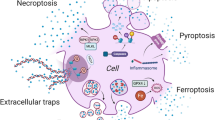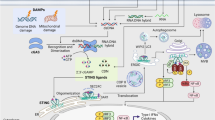Abstract
Inflammatory and infectious conditions were simulated in cultures of ras/myc-transformed serum-free mouse embryo (ras/myc SFME) cells, using interferon-gamma (IFN-γ, 100 units/ml) and lipopolysaccharide (LPS, 0.5 μg/ml) co-treatment for 24 h, to investigate their effects on the expression of inducible nitric oxide synthase (iNOS) mRNA and the production of NO. Aminoguanidine (AG, 1 mM; an NOS inhibitor) along with IFN-γ and LPS, S-nitroso-N-acetyl-DL-penicillamine (SNAP, 100 μM; an NO donor) and/or (±)-N-[(E)-4-Ethyl-2-[(Z)-hydroxyimino]-5-nitro-3-hexene-1-yl]-3-pyridine carboxamide (NOR4, 100 μM; an NO donor), were also added to analyze the possible association of NO with matrix metalloproteinase-9 (MMP-9) and tissue inhibitor of metalloproteinase-1 (TIMP-1). Co-treatment of cells with IFN-γ and LPS increased iNOS mRNA expression, NO production, MMP-9 mRNA expression, and 105 kDa MMP-9 production. Additional treatment with the NOS inhibitor AG inhibited NO production, but did not down-regulate the expression of MMP-9 mRNA or 105 kDa MMP-9. The NO donors SNAP and NOR4 did not affect the expression of MMP-9 mRNA, 105 kDa MMP-9 or TIMP-1 mRNA. These results suggest that ras/myc SFME cells respond to infectious and inflammatory conditions and can enhance malignancy as cancer cells due to their increased levels of NO and MMP-9 production, but that NO is not directly associated with MMP-9 in these cells.






Similar content being viewed by others
Abbreviations
- AG:
-
Aminoguanidine
- ECM:
-
Extracellular matrix
- EGF:
-
Epidermal growth factor
- IFN-γ:
-
Interferon-gamma
- iNOS:
-
Inducible nitric oxide synthase
- IRF-1:
-
Interferon regulatory factor-1
- LPS:
-
Lipopolysaccharide
- MMP:
-
Matrix metalloproteinase
- NF-κB:
-
Nuclear factor-kappaB
- NO:
-
Nitric oxide
- NOR4:
-
(±)-N-[(E)-4-ethyl-2-[(Z)-hydroxyimino]-5-nitro-3-hexene-1-yl]-3-pyridine carboxamide
- NOS:
-
Nitric oxide synthase
- SFME:
-
Serum-free mouse embryo
- SNAP:
-
S-nitroso-N-acetyl-DL-penicillamine
- TIMP-1:
-
Tissue inhibitor of metalloproteinase-1
References
Moncada S (1992) The 1991 Ulf von Euler Lecture. The l-arginine: nitric oxide pathway. Acta Physiol Scand 145:201–227
Nathan C (1992) Nitric oxide as a secretory product of mammalian cells. FASEB J 6:3051–3064
Moncada S, Palmer RM, Higgs EA (1991) Nitric oxide: physiology, pathophysiology, and pharmacology. Pharmacol Rev 43:109–142
Ryoyama K (1992) Effector molecules from antitumor macrophages induced with OK-432 and cyclophosphamide. Cancer Immunol Immunother 35:7–13
Dong Z, Staroselsky AH, Qi X et al (1994) Inverse correlation between expression of inducible nitric oxide synthase activity and production of metastasis in K-1735 murine melanoma cells. Cancer Res 54:789–793
Xie K, Huang S, Dong Z et al (1995) Transfection with the inducible nitric oxide synthase gene suppresses tumorigenicity and abrogates metastasis by K-1735 murine melanoma cells. J Exp Med 181:1333–1343
Juang SH, Xie K, Xu L et al (1998) Suppression of tumorigenicity and metastasis of human renal carcinoma cells by infection with retroviral vectors harboring the murine inducible nitric oxide synthase gene. Hum Gene Ther 9:845–854
Edwards P, Cendan JC, Topping DB et al (1996) Tumor cell nitric oxide inhibits cell growth in vitro, but stimulates tumorigenesis and experimental lung metastasis in vivo. J Surg Res 63:49–52
Shi Q, Xiong Q, Wang B et al (2000) Influence of nitric oxide synthase II gene disruption on tumor growth and metastasis. Cancer Res 60:2579–2583
Gallo O, Masini E, Morbidelli L et al (1998) Role of nitric oxide in angiogenesis and tumor progression in head and neck cancer. J Natl Cancer Inst 90:587–596
Xie K, Fidler IJ (1998) Therapy of cancer metastasis by activation of the inducible nitric oxide synthase. Cancer Metastasis Rev 17:55–75
Nagase H, Woessner JFJr (1999) Matrix metalloproteinases. J Biol Chem 274:21491–21494
Bernhard EJ, Gruber SB, Muschel RJ (1994) Direct evidence linking expression of matrix metalloproteinase 9 (92-kDa gelatinase/collagenase) to the metastatic phenotype in transformed rat embryo cells. Proc Natl Acad Sci USA 91:4293–4297
Murrell GA, Jang D, Williams RJ (1995) Nitric oxide activates metalloprotease enzymes in articular cartilage. Biochem Biophys Res Commun 206:15–21
Tamura T, Nakanishi T, Kimura Y et al (1996) Nitric oxide mediates interleukin-1-induced matrix degradation and basic fibroblast growth factor release in cultured rabbit articular chondrocytes: a possible mechanism of pathological neovascularization in arthritis. Endocrinology 137:3729–3737
Marcet-Palacios M, Graham K, Cass C et al (2003) Nitric oxide and cyclic GMP increase the expression of matrix metalloproteinase-9 in vascular smooth muscle. J Pharmacol Exp Ther 307:429–436
Yoshida M, Sagawa N, Itoh H et al (2001) Nitric oxide increases matrix metalloproteinase-1 production in human uterine cervical fibroblast cells. Mol Hum Reprod 7:979–985
Orucevic A, Bechberger J, Green AM et al (1999) Nitric-oxide production by murine mammary adenocarcinoma cells promotes tumor-cell invasiveness. Int J Cancer 81:889–896
Horton WEJr, Udo I, Precht P et al (1998) Cytokine inducible matrix metalloproteinase expression in immortalized rat chondrocytes is independent of nitric oxide stimulation. In Vitro Cell Dev Biol Anim 34:378–384
Ledingham MA, Denison FC, Riley SC et al (1999) Matrix metalloproteinases-2 and -9 and their inhibitors are produced by the human uterine cervix but their secretion is not regulated by nitric oxide donors. Hum Reprod 14:2089–2096
Eberhardt W, Beeg T, Beck KF et al (2000) Nitric oxide modulates expression of matrix metalloproteinase-9 in rat mesangial cells. Kidney Int 57:59–69
Gurjar MV, DeLeon J, Sharma RV et al (2001) Mechanism of inhibition of matrix metalloproteinase-9 induction by NO in vascular smooth muscle cells. J Appl Physiol 91:1380–1386
Xie QW, Kashiwabara Y, Nathan C (1994) Role of transcription factor NF-kappa B/Rel in induction of nitric oxide synthase. J Biol Chem 269:4705–4708
Arechavaleta-Velasco F, Ogando D, Parry S et al (2002) Production of matrix metalloproteinase-9 in lipopolysaccharide-stimulated human amnion occurs through an autocrine and paracrine proinflammatory cytokine-dependent system. Biol Reprod 67:1952–1958
Taubman MA, Kawai T (2001) Involvement of T-lymphocytes in periodontal disease and in direct and indirect induction of bone resorption. Crit Rev Oral Biol Med 12:125–135
Cenci S, Toraldo G, Weitzmann MN et al (2003) Estrogen deficiency induces bone loss by increasing T cell proliferation and lifespan through interferon-γ-induced class II transactivator. Proc Natl Acad Sci USA 100:10405–10410
Van Roon JA, Glaudemans KA, Bijlsma JW et al (2003) Interleukin 7 stimulates tumour necrosis factor alpha and Th1 cytokine production in joints of patients with rheumatoid arthritis. Ann Rheum Dis 62:113–119
Taubman MA, Valverde P, Han X et al (2005) Immune response: the key to bone resorption in periodontal disease. J Periodontol 76:2033–2041
Weitzmann MN, Pacifici R (2006) Estrogen deficiency and bone loss: an inflammatory tale. J Clin Invest 116:1186–1194
Kidachi Y, Yamaguchi H, Umetsu H et al (2007) Interferon-gamma and lipopolysaccharide stimulation increases matrix metalloproteinase-9 expression and enhances invasion activity in ras/myc-transformed serum-free mouse embryo cells. Cell Biol Int (in press)
Loo DT, Fuquay JI, Rawson CL et al (1987) Extended culture of mouse embryo cells without senescence: inhibition by serum. Science 236:200–202
Loo D, Rawson C, Helmrich A et al (1989) Serum-free mouse embryo (SFME) cells: growth responses in vitro. J Cell Physiol 139:484–491
Alonso S, Minty A, Bourlet Y et al (1986) Comparison of three actin-coding sequences in the mouse; evolutionary relationships between the actin genes of warm-blooded vertebrates. J Mol Evol 23:11–22
Kone BC, Schwobel J, Turner P et al (1995) Role of NF-kappa B in the regulation of inducible nitric oxide synthase in an MTAL cell line. Am J Physiol 269:F718–F729
Masure S, Nys G, Fiten P et al (1993) Mouse gelatinase B: cDNA cloning, regulation of expression and glycosylation in WEHI-3 macrophages and gene organisation. Eur J Biochem 218:129–141
Edwards DR, Waterhouse P, Holman ML et al (1986) A growth-responsive gene (16C8) in normal mouse fibroblasts homologous to a human collagenase inhibitor with erythroid-potentiating activity: evidence for inducible and constitutive transcripts. Nucleic Acids Res 14:8863–8878
Tanaka H, Hojo K, Yoshida H et al (1993) Molecular cloning and expression of the mouse 105-kDa gelatinase cDNA. Biochem Biophys Res Commun 190:732–740
Rawson C, Cosola-Smith C, Barnes D (1990) Death of serum-free mouse embryo cells caused by epidermal growth factor deprivation is prevented by cycloheximide, 12-O-tetradecanoylphorbol-13-acetate, or vanadate. Exp Cell Res 186:177–181
Rawson C, Shirahata S, Collodi P et al (1991) Oncogene transformation frequency of nonsenescent SFME cells is increased by c-myc. Oncogene 6:487–489
Ondruschka C, Buhtz P, Motsch C et al (2002) Prognostic value of MMP-2, -9 and TIMP-1,-2 immunoreactive protein at the invasive front in advanced head and neck squamous cell carcinomas. Pathol Res Pract 198:509–515
Stetler-Stevenson WG, Aznavoorian S, Liotta LA (1993) Tumor cell interactions with the extracellular matrix during invasion and metastasis. Annu Rev Cell Biol 9:541–573
Mori M, Barnard GF, Mimori K et al (1995) Overexpression of matrix metalloproteinase-7 mRNA in human colon carcinomas. Cancer 75:1516–1519
Seiki M (1996) Membrane type-matrix metalloproteinase and tumor invasion. Curr Top Microbiol Immunol 213:23–32
Airola K, Johansson N, Kariniemi AL et al (1997) Human collagenase-3 is expressed in malignant squamous epithelium of the skin. J Invest Dermatol 109:225–231
Johansson N, Airola K, Grenman R et al (1997) Expression of collagenase-3 (matrix metalloproteinase-13) in squamous cell carcinomas of the head and neck. Am J Pathol 151:499–508
Kataoka H, Meng JY, Uchino H et al (1997) Modulation of matrix metalloproteinase-7 (matrilysin) secretion in coculture of human colon carcinoma cells with fibroblasts from orthotopic and ectopic organs. Oncol Res 9:101–109
Nielsen BS, Sehested M, Kjeldsen L et al (1997) Expression of matrix metalloprotease-9 in vascular pericytes in human breast cancer. Lab Invest 77:345–355
Trachtman H, Futterweit S, Garg P et al (1996) Nitric oxide stimulates the activity of a 72-kDa neutral matrix metalloproteinase in cultured rat mesangial cells. Biochem Biophys Res Commun 218:704–708
Sasaki K, Hattori T, Fujisawa T et al (1998) Nitric oxide mediates interleukin-1-induced gene expression of matrix metalloproteinases and basic fibroblast growth factor in cultured rabbit articular chondrocytes. J Biochem (Tokyo) 123:431–439
Eberhardt W, Huwiler A, Beck KF et al (2000) Amplification of IL-1 beta-induced matrix metalloproteinase-9 expression by superoxide in rat glomerular mesangial cells is mediated by increased activities of NF-kappa B and activating protein-1 and involves activation of the mitogen-activated protein kinase pathways. J Immunol 165:5788–5797
Tanimura S, Asato K, Fujishiro SH et al (2003) Specific blockade of the ERK pathway inhibits the invasiveness of tumor cells: down-regulation of matrix metalloproteinase-3/-9/-14 and CD44. Biochem Biophys Res Commun 304:801–806
Gao Y, Grass F, Ryan MR et al (2007) IFN-γ stimulates osteoclast formation and bone loss in vivo via antigen-driven T cell activation. J Clin Invest 117:122–132
Gao JJ, Filla MB, Fultz MJ et al (1998) Autocrine/paracrine IFN-αβ mediates the lipopolysaccharide-induced activation of transcription factor Stat1α in mouse macrophages: pivotal role of Stat1α in induction of the inducible nitric oxide synthase gene. J Immunol 161:4803–4810
Sanceau J, Boyd DD, Seiki M et al (2002) Interferons inhibit tumor necrosis factor-α-mediated matrix metalloproteinase-9 activation via interferon regulatory factor-1 binding competition with NF-κB. J Biol Chem 277:35766–35775
Rogers JA, Fuseler JW (2007) Regulation of NF-kappaB activation and nuclear translocation by exogenous nitric oxide (NO) donors in TNF-alpha activated vascular endothelial cells. Nitric Oxide 16:379–391
Lim S, Roche N, Oliver BG et al (2000) Balance of matrix metalloprotease-9 and tissue inhibitor of metalloprotease-1 from alveolar macrophages in cigarette smokers. Regulation by interleukin-10. Am J Respir Crit Care Med 162:1355–1360
Acknowledgments
We thank Dr. Shirahata of Kyushu University, Japan, for the gift of ras/myc SFME cells. This study was partly supported by a grant-in-aid from the Promotion and Mutual Aid Corporation for Private Schools of Japan.
Author information
Authors and Affiliations
Corresponding author
Additional information
H. Yamaguchi and Y. Kidachi contributed equally to this work
Rights and permissions
About this article
Cite this article
Yamaguchi, H., Kidachi, Y., Umetsu, H. et al. Ras/myc-transformed serum-free mouse embryo cells under simulated inflammatory and infectious conditions increase levels of nitric oxide and matrix metalloproteinase-9 without a direct association between them. Mol Cell Biochem 306, 43–51 (2007). https://doi.org/10.1007/s11010-007-9552-0
Received:
Accepted:
Published:
Issue Date:
DOI: https://doi.org/10.1007/s11010-007-9552-0




